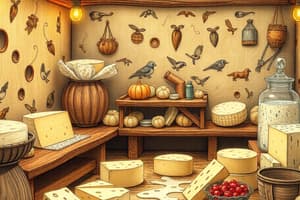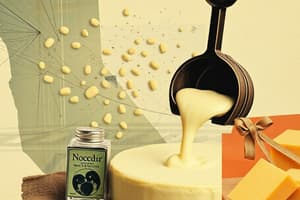Podcast
Questions and Answers
What is the primary component of milk by percentage?
What is the primary component of milk by percentage?
- Carbohydrates
- Fat
- Protein
- Water (correct)
Which of the following best describes whole milk in terms of its physical classification?
Which of the following best describes whole milk in terms of its physical classification?
- A gas
- A solid suspension
- A solution, dispersion, or emulsion (correct)
- A colloid
What is the purpose of homogenization in milk processing?
What is the purpose of homogenization in milk processing?
- To improve vitamin absorption
- To enhance flavor
- To prevent creaming (correct)
- To increase fat content
Which vitamin must low-fat milk typically be fortified with to meet regulatory standards?
Which vitamin must low-fat milk typically be fortified with to meet regulatory standards?
What can be a consequence of bleaching on vitamin content in milk?
What can be a consequence of bleaching on vitamin content in milk?
Which ingredient is commonly used as a bleaching agent in milk processing?
Which ingredient is commonly used as a bleaching agent in milk processing?
What is the typical protein content in whole milk?
What is the typical protein content in whole milk?
In the context of milk processing, what does fortification primarily aim to address?
In the context of milk processing, what does fortification primarily aim to address?
Which component of milk is primarily responsible for its energy content?
Which component of milk is primarily responsible for its energy content?
Which of the following is NOT a common processing technique for milk?
Which of the following is NOT a common processing technique for milk?
What is the main purpose of pasteurization in milk processing?
What is the main purpose of pasteurization in milk processing?
Which of the following is a consequence of consuming high-fat dairy products?
Which of the following is a consequence of consuming high-fat dairy products?
What is MSNF in the context of milk composition?
What is MSNF in the context of milk composition?
Cheesemaking primarily involves which process?
Cheesemaking primarily involves which process?
Which milk product has undergone the process of culturing?
Which milk product has undergone the process of culturing?
What characteristic is essential for whole milk compared to reduced-fat varieties?
What characteristic is essential for whole milk compared to reduced-fat varieties?
Which statement accurately describes the definition of cheese as provided by the FDA?
Which statement accurately describes the definition of cheese as provided by the FDA?
What is the primary role of chymosin in the cheesemaking process?
What is the primary role of chymosin in the cheesemaking process?
From 10 lbs of milk, how much cheese is produced according to the information provided?
From 10 lbs of milk, how much cheese is produced according to the information provided?
Which component is NOT typically found in cheese?
Which component is NOT typically found in cheese?
What common misconception do people have about the fat content in cheese?
What common misconception do people have about the fat content in cheese?
Which of the following enzymes is involved in coagulating milk to form curds?
Which of the following enzymes is involved in coagulating milk to form curds?
Health effects of cheese consumption could include which of the following?
Health effects of cheese consumption could include which of the following?
Which statement best describes the use of enzymes in the cheesemaking process?
Which statement best describes the use of enzymes in the cheesemaking process?
Flashcards are hidden until you start studying
Study Notes
Cheese
- The FDA defines cheese as a product made from milk curds obtained from cows, or other animals with or without added cream.
- Cheese is made by coagulating milk curds with rennet, lactic acid, or other enzymes.
- Cheese is ripened using special molds or seasoning.
- Cheese contains casein, fat, minerals, and milk serum, including whey proteins, lactose, and water-soluble vitamins.
- It takes 10 lbs of milk to make 1 lb of cheese.
Milk
- An average of 87 to 88% of milk is water.
- Milk contains approximately 3.5% fat in whole milk, with saturated fat being the primary type.
- Milk contains carbohydrates like lactose at a level of less than 5%, and 3 to 4% protein.
- Milk is classified as a solution, dispersion, or emulsion based on its components.
- Milk is processed through pasteurization to kill harmful bacteria.
- Homogenization prevents fat from separating and rising to the top of the milk container.
- Fat droplet size is altered during homogenization.
- Fortification of milk with fat-soluble vitamins A and D is optional.
- Low-fat milk, nonfat milk, and low-fat chocolate milk must be fortified with 2000 International Units (IU) or 140 Retinol Equivalents (RE) vitamin A per quart.
- Bleaching of milk with benzoyl peroxide (BP) is allowed by the FDA for flavor and color enhancement.
- Vitamin A or its precursors can be destroyed during bleaching, causing the need for added vitamin A during processing.
Dairy
- Milk and milk products are produced by the mammary glands of female mammals.
- Milk is a mixture of fat, high-quality protein, and water.
- Milk contains carbohydrates, vitamins, and minerals.
- Milk and milk products are obtained from different species, such as goats, sheep, and cows.
- Milk is graded based on the percentage of milk solids and milk solids, not fat (MSNF).
- Milk can be cultured, dried, fortified, homogenized, or pasteurized to alter its taste, texture, nutritive value, and shelf life.
- Some examples of milk products include buttermilk, cheese, cream, ice milk, ice cream, sour cream, and yogurt.
- The fat content of these products can vary significantly.
Milk Coagulation
- Chymosin, or rennet, is a proteolytic enzyme that coagulates milk to prevent rapid flow in the digestive tract.
- Chymosin is synthesized by chief cells in the stomach of young ruminant animals like lambs, calves, and goats.
- Animal, plant, and microbial protease enzymes can be used to clot milk and form curds.
- Curds are formed as a result of casein coagulation by rennet or lactic acid.
Studying That Suits You
Use AI to generate personalized quizzes and flashcards to suit your learning preferences.




